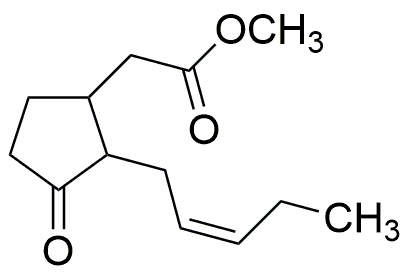Methyl jasmonate is widely utilized in research focused on:
- Agricultural Enhancements: This compound is used as a plant growth regulator, promoting stress resistance and enhancing the quality of crops. For instance, it can improve fruit ripening and increase essential oil production in aromatic plants.
- Pharmaceutical Development: Methyl jasmonate has shown potential in drug formulation due to its ability to modulate biological pathways. Researchers are exploring its role in developing anti-inflammatory and anti-cancer agents.
- Flavor and Fragrance Industry: It is used as a natural flavoring agent and fragrance component, providing a pleasant aroma in perfumes and food products, making it a preferred choice over synthetic alternatives.
- Biopesticide Formulations: This compound is being investigated for its efficacy in developing eco-friendly pesticides, offering a sustainable option for pest control in agriculture without harming beneficial insects.
- Cosmetic Applications: Methyl jasmonate is incorporated into skincare products for its antioxidant properties, helping to protect the skin from environmental stressors and improve overall skin health.
General Information
Properties
Safety and Regulations
Applications
Methyl jasmonate is widely utilized in research focused on:
- Agricultural Enhancements: This compound is used as a plant growth regulator, promoting stress resistance and enhancing the quality of crops. For instance, it can improve fruit ripening and increase essential oil production in aromatic plants.
- Pharmaceutical Development: Methyl jasmonate has shown potential in drug formulation due to its ability to modulate biological pathways. Researchers are exploring its role in developing anti-inflammatory and anti-cancer agents.
- Flavor and Fragrance Industry: It is used as a natural flavoring agent and fragrance component, providing a pleasant aroma in perfumes and food products, making it a preferred choice over synthetic alternatives.
- Biopesticide Formulations: This compound is being investigated for its efficacy in developing eco-friendly pesticides, offering a sustainable option for pest control in agriculture without harming beneficial insects.
- Cosmetic Applications: Methyl jasmonate is incorporated into skincare products for its antioxidant properties, helping to protect the skin from environmental stressors and improve overall skin health.
Documents
Safety Data Sheets (SDS)
The SDS provides comprehensive safety information on handling, storage, and disposal of the product.
Product Specification (PS)
The PS provides a comprehensive breakdown of the product’s properties, including chemical composition, physical state, purity, and storage requirements. It also details acceptable quality ranges and the product's intended applications.
Certificates of Analysis (COA)
Search for Certificates of Analysis (COA) by entering the products Lot Number. Lot and Batch Numbers can be found on a product’s label following the words ‘Lot’ or ‘Batch’.
*Catalog Number
*Lot Number
Certificates Of Origin (COO)
This COO confirms the country where the product was manufactured, and also details the materials and components used in it and whether it is derived from natural, synthetic, or other specific sources. This certificate may be required for customs, trade, and regulatory compliance.
*Catalog Number
*Lot Number
Safety Data Sheets (SDS)
The SDS provides comprehensive safety information on handling, storage, and disposal of the product.
DownloadProduct Specification (PS)
The PS provides a comprehensive breakdown of the product’s properties, including chemical composition, physical state, purity, and storage requirements. It also details acceptable quality ranges and the product's intended applications.
DownloadCertificates of Analysis (COA)
Search for Certificates of Analysis (COA) by entering the products Lot Number. Lot and Batch Numbers can be found on a product’s label following the words ‘Lot’ or ‘Batch’.
*Catalog Number
*Lot Number
Certificates Of Origin (COO)
This COO confirms the country where the product was manufactured, and also details the materials and components used in it and whether it is derived from natural, synthetic, or other specific sources. This certificate may be required for customs, trade, and regulatory compliance.


